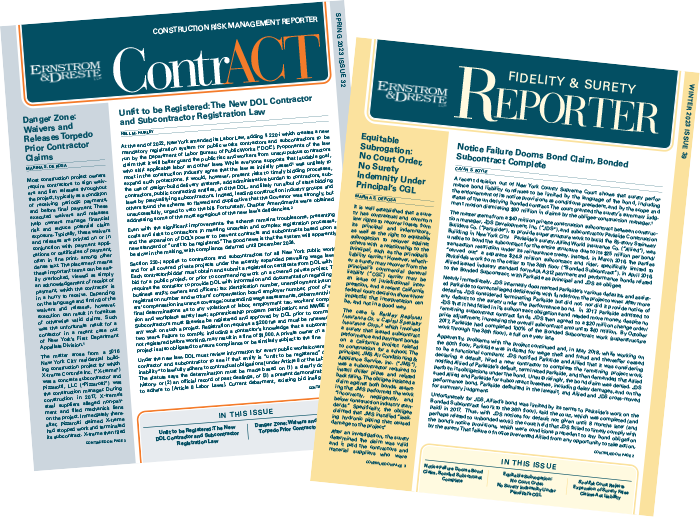Article by: Nell M. Hurley
In a recent Maryland case, an obligee’s failure to provide notice to the surety under an AIA A312 performance bond1 resulted in the dismissal of the obligee’s claim where the surety learned of the default and termination only after the work had been completed by another contractor.2 The intermediate appellate court determined that:
- The failure was a material breach that discharged the surety’s obligation under the bond;
- The bond language3 did not require the surety to prove actual prejudice; and
- The surety was prejudiced as a matter of law when it was precluded from exercising its bond right to elect a remedial option.4
The result reaffirms the fundamental importance of allowing a surety to exercise its options.
The matter stems from the construction of an assisted living facility that included the creation of a submerged gravel wetland (“SGW”) to manage stormwater. Wildewood Operating Company, LLC (“Wildewood”) contracted with Clark Turner Construction, LLC (“Clark Turner”) to perform the work. An AIA A312 (2010) performance bond was issued by surety First Indemnity of America Insurance Company (‘First Indemnity”) with Clark Turner as principal and Wildewood as obligee. The January 2013 contract required completion within one year of work commencement.
Although Clark Turner timely constructed the SGW, in February 2014 the work was declared “not in compliance” by county officials and Clark Turner failed to correct the issues. In July 2014, Wildewood executed a contract to sell the facility to a third party, scheduled to close in November 2014. Come November, government approvals were still lacking so various parties, including Wildewood, Clark Turner, and the intended new owner (but not First Indemnity) entered into a “Work Agreement” requiring proper approvals by June 2015. When Clark Turner failed to comply, another contractor completed the work at Wildewood’s expense under the Work Agreement.
Wildewood notified First Indemnity on November 3, 2015, that it was considering declaring Clark Turner in default under the bond (Section 3.1). It further advised of the property’s sale and Wildewood’s payment for the SGW work’s completion under the Work Agreement. On November 20, 2015, Wildewood notified First Indemnity that it declared Clark Turner in default and terminated the bonded contract, stated that it had complied with Section 3 of the bond, and demanded the surety act under Section 5. First Indemnity denied the claim. In 2017, suit was commenced by Wildewood and others, seeking damages of $150,000, the amount paid for completing the work.
First Indemnity moved for summary judgment, which was granted. The motion court found that completion of the work prior to giving the surety notice under Section 3.2 was a failure to comply with a condition precedent, which deprived the surety of its right to elect a remedy under the bond, resulted in inherent prejudice, and discharged its bond obligation.
On appeal to the Maryland Appellate Court, the decision was affirmed.5 The court rejected Wildewood’s arguments that the notice given satisfied Section 3.2 and that First Indemnity must demonstrate actual prejudice.
In a matter of first impression in Maryland, the court instead ruled that notice of declaration of default and termination under Section 3.2 prior to work completion was a condition precedent, despite the absence of an explicit “timely” notice requirement. The court reasoned that the performance bond is properly read as requiring the obligee to notify the surety of the default before engaging in self-help remedies, noting:
“Otherwise, the explicit grant to the surety of a right to remedy the default would be operative only if the obligee chose to give it notice, thereby rendering the options in Section 5 nearly meaningless.”
Since Wildewood’s notice to First Indemnity happened only after the work was completed, it was untimely, the court found, meaning the condition precedent to First Indemnity’s bond obligation did not occur and its obligation was thus discharged.
Wildewood’s second contention was likewise unsuccessful, and the court dismissed its argument that a failure of notice under any bond section invoked the Section 4 “actual prejudice” requirement upon the surety.6 The plain reading of the bond shows that requirement applies only to notice under Section 3.1 (regarding “considering declaring” a default) and not to Section 3.2 (regarding default and termination), said the court. The court continued:
“Even if the bond required [the surety] to demonstrate actual prejudice to avoid liability, we conclude … [the surety] was prejudiced as a matter of law when it was precluded from exercising its rights under Section 5.”
This decision is consistent with important underlying principles of surety law that protect the right of the surety to choose how to respond to an alleged default. It should be comforting to surety professionals to see additional jurisdictions reaffirm this basic precept and reject efforts to expand the surety’s obligations under this commonly used industry bond form.7
- American Institute of Architects AIA Document A312® – 2010 Performance Bond.
- Wildewood Operating Co., LLC v. WRV Holding, LLC, et al. 259 Md. App. 464 (2023).
- Section 3.2 requires notice to the surety of contractor default and contract termination.
- Section 5 provides the surety four specific options to meet its bond obligation once it receives notice under Section 3.2.
- The motion court also concluded that First Indemnity was discharged when Wildewood entered into the Work Agreement, an argument not reached by the appellate court.
- Section 4 states, in essence, that a notice failure under Section 3.1 (requiring notice of “considering declaring” a default) is not failure of a condition precedent and only releases the surety to the extent of actual prejudice shown.
- The appellate court relied on precedent from other jurisdictions, particularly those of the D.C. District Court.





